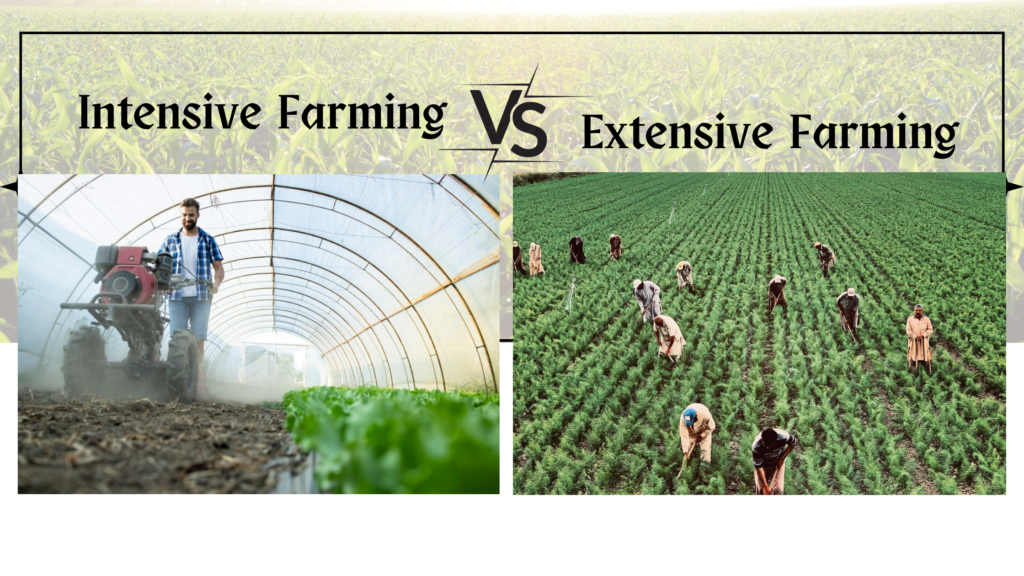Intensive Farming and Extensive Farming
Two opposing strategies have become leading rivals in the field of agriculture: extensive farming and intensive farming. These approaches reflect various ideologies and methods, each with pros and cons of its own. Understanding the differences between these two strategies is crucial as global issues like socio economic fairness, environmental sustainability, and food security grow more pressing. Let’s examine the contrast between extensive and intensive farming practices in more detail.
Defining Ex:
Intensive farming, sometimes known as industrial agriculture, is defined by its emphasis on increasing productivity per unit of land by using large inputs of labor, money, and technology. With the use of contemporary methods like mechanization, chemical inputs, and genetically modified organisms (GMOs), this strategy seeks to provide maximum yields. Below is a summary of its salient attributes:
- High Inputs, High Yields: – To increase production, intensive farming mostly depends on outside inputs like machinery, insecticides, and fertilizers. The objective is to maximize production from the limited amount of land available, which frequently results in monoculture techniques where a single crop dominates large areas of land.
- Technological Advancements: – To improve efficiency and streamline operations, intensive farming adopts technological advancements.
– Mechanisation is essential since it increases output per unit of labor input and decreases the need for manual labor.
- Environmental Concerns:-Intense cultivation creates serious environmental issues notwithstanding production advances.
– The use of chemical pesticides and fertilizers can cause biodiversity loss, water pollution, and soil deterioration.
– Crops grown in monocultures are more susceptible to pests and diseases, requiring additional chemical treatments.
Exploring Extensive Farming:
Extensive farming, commonly referred to as traditional or extended agriculture, employs a low-input, more comprehensive approach to land utilization than intensive farming. This approach places a strong emphasis on community resilience, sustainability, and biodiversity preservation. Let’s look at its distinguishing features:
- Low Input, Sustainable Practices: – Conventional agricultural techniques and natural processes are employed in large-scale farming to reduce the need for external inputs like pesticides and fertilizers. Agroforestry, crop rotation, and intercropping are typical techniques that promote soil health and biodiversity preservation.
- Emphasis on Livestock Grazing: – The importance of livestock grazing is highlighted by the following: –
Livestock are the backbone of large-scale farming systems; they frequently graze on pastureland and forage on organic plants. Livestock and the land have a symbiotic interaction that supports soil fertility, nutrient cycling, and ecological equilibrium.
- Socio-Economic Implications: – Widespread farming maintains traditional farming communities and rural livelihoods while safeguarding regional knowledge and cultural legacy. Extensive farming supports community resilience and food sovereignty by promoting decentralized food systems and diverse agriculture.
Navigating the Trade-offs:
It is clear that both intensive and extensive farming include trade-offs between productivity, sustainability, and socioeconomic factors as we compare their respective benefits. Let’s take a closer look at these trade-offs:
- Productivity vs. Sustainability:
– Intensive farming effectively meets the demands of an expanding global population by optimizing productivity and output per unit of land. Nevertheless, the loss of biodiversity, depletion of the soil, and environmental degradation are frequently the costs of high production.
– Extensive farming, on the other hand, places a higher priority on sustainability and ecosystem health, encouraging resource conservation and long-term resilience.
– Extensive farming may produce less per unit of land, but its regenerative techniques improve biodiversity, soil fertility, and climate resilience.
- Economic Viability vs. Social Equity:
Because intensive farming places a strong focus on production and efficiency, farmers may see larger short-term financial rewards from it. However, since small-scale farmers find it difficult to compete with industrialized agribusinesses, these financial advantages can come at the expense of rural livelihoods.
On the other side, extensive farming promotes social cohesiveness and cultural identity by helping local economies and traditional farming communities.
– Extensive farming tackles socioeconomic disparities and gives marginalized farmers a voice by supporting varied agriculture and fair land allocation.
Towards a Balanced Approach:
It is essential to use a balanced approach that incorporates the benefits of both extensive and intensive farming in order to successfully navigate the complexity of modern agriculture. The following tactics can help you strike this balance:
- Agroecological Principles: – Based on ecological resilience, biodiversity conservation, and community well-being, agroecology provides a framework for sustainable farming techniques. Through the integration of scientific and traditional knowledge, agroecology advances regenerative agriculture, which benefits both the environment and human health.
- Innovation and Technology: – The efficiency and sustainability of agricultural output can be improved by developments in digital farming equipment, renewable energy, and precision agriculture. We can take advantage of the productivity advantages of intensive farming while reducing its negative effects by using innovation wisely.
- Policy Support and Advocacy: – Through encouraging laws and financial rewards, governments, legislators, and other agricultural stakeholders have a significant impact on how farming will develop in the future.
– Investments in farmer education, extension services, and research can help us move towards more egalitarian and sustainable agricultural systems.
Conclusion:
The contrast between extensive and intensive farming highlights the necessity for a comprehensive and nuanced approach to food production as we stand at the crossroads of agriculture. We can build a future where agriculture feeds people and the earth by valuing diversity, creativity, and teamwork. Together, let’s create regenerative and resilient food systems that can sustainably feed both the current and coming generations.

